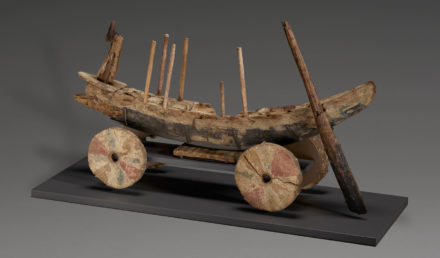
The Evil Genius, the Emperor, Henri Zislin (French, 1875–1958). Color lithograph from L’armée allemande (Paris, 1914). The Getty Research Institute, 92-B3128
This lithograph embodies many of the themes of the Getty Research Institute’s exhibition World War I: War of Images, Images of War, which opens today. The exhibition takes as its central premise that the First World War was a conflict not only of modern weaponry but also of cultural dominance over the European continent.
An ominous vision of Kaiser Wilhelm II wearing a vast cape and surrounded by a colony of bats, this image comes from a suite of ten lithographs satirizing members of the German army. The artist, Henri Zislin, was born in 1875 in the city of Mulhouse, which had been under German control since Germany annexed Alsace-Lorraine at the conclusion of the Franco-Prussian war. Crucially, Zislin never considered himself to be German, but, rather, French. Even before the outbreak of World War I, he employed sardonic imagery to caricature German officials, for which he was jailed on several occasions. Zislin’s native Mulhouse was the site of an early battle in August 1914 in which France attempted unsuccessfully to retake Alsace from Germany.
Zislin’s image of the Kaiser appears in the “Allies and Enemies” section of the exhibition, which traces the visual codes developed by the main participating nations—France, Germany, United Kingdom, Russia, Italy—in the form of animal symbols, personifications, and body types. Such codes were used, often in exaggerated form (a Satanic Kaiser, a flustered French cock), in the propaganda of satirical journals, in which individual nations sought to elevate their own culture, while denigrating the enemy.

Black-Booker, hand-colored lithograph from Kartinki—voina russkikh s nemtsami (Pictures—The Russian War with the Germans) (Petrograd, 1914), pl. 31. The Getty Research Institute, 92-F293
Kaiser Wilhelm’s militarism made him the most popular image of anti-German propaganda, not only for the French, but also for the Russians and the Americans. A Russian popular print also in the exhibition shows the Kaiser as a warlock or “Black Booker” wearing bat wings and penning the statement, “I declare war on all Europe.”
World War I: War of Images, Images of War is on view at the Getty Research Institute through April 19, 2015.




Comments on this post are now closed.